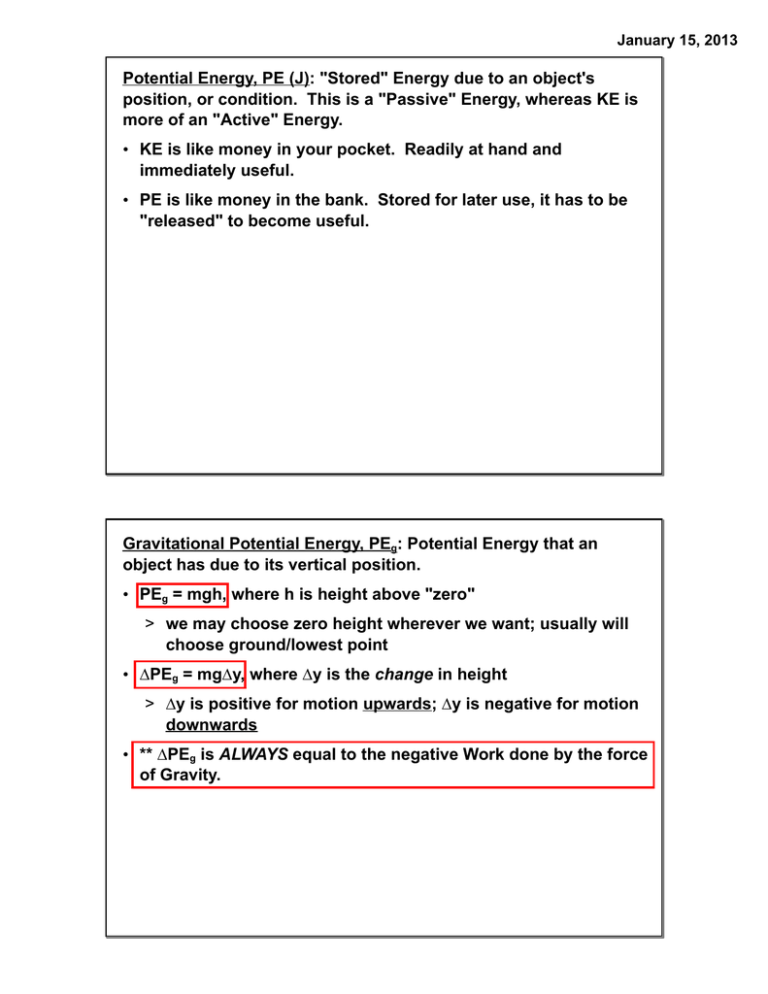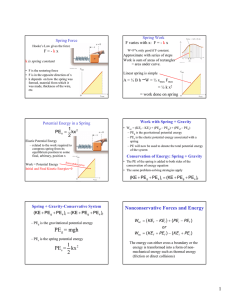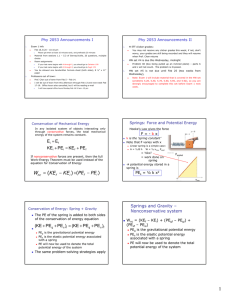Potential Energy, PE (J): "Stored" Energy due to an object`s position
advertisement

January 15, 2013 Potential Energy, PE (J): "Stored" Energy due to an object's position, or condition. This is a "Passive" Energy, whereas KE is more of an "Active" Energy. • KE is like money in your pocket. Readily at hand and immediately useful. • PE is like money in the bank. Stored for later use, it has to be "released" to become useful. Gravitational Potential Energy, PEg: Potential Energy that an object has due to its vertical position. • PEg = mgh, where h is height above "zero" > we may choose zero height wherever we want; usually will choose ground/lowest point • ∆PEg = mg∆y, where ∆y is the change in height > ∆y is positive for motion upwards; ∆y is negative for motion downwards • ** ∆PEg is ALWAYS equal to the negative Work done by the force of Gravity. January 15, 2013 Ex. 1: A 70 kg student walks to the top of the stairs, which are 2.7 meters tall. a) How much work is done by gravity? b) What is the change in PEg? Ex. 2: A 10 kg object is lifted from the floor to a point 2.0 meters above the floor. a) How much PEg does the object have relative to the floor? b) How much work is done by gravity as the object is lifted? c) *If the object is dropped, what is its speed when it hits the floor? January 15, 2013 Ex. 3: A weightlifter exerts a force F = 360 N on a weight with a mass of 30 kg. The weight is lifted a distance of 1.5 meters. a) What is the work done by the weightlifter? b) What is the change in PEg? c) What is the total work done to the weight? Spring Potential Energy, PEs: This is the energy stored in a spring (or some other "elastic" object) by changing its condition/shape (bending, stretching, compressing) from a relaxed state. • The amount of energy stored depends on the "stiffness" of the object/material, and by how far/much the shape is changed. • For a standard spring, PEs = 1/2(k)(x2) > k is known as the "Spring Constant"; it is a way to quantify the stiffness of a spring; measured in N/m > x is the distance from a relaxed state that the spring is stretched/compressed > in its "relaxed", "regular" or "equilibrium" state, x = 0, and so PEs = 0 > PEs is, like KE, always ≥ 0 January 15, 2013 ∆PEs = PEs,f - PEs,0 • can be positive, negative, or zero > when positive, xf > x0; you do +Work on the spring > when negative, xf < x0; you do -Work on the spring > when zero, xf = x0; you do 0 Work on the spring • is equal to the work that you do on the spring




